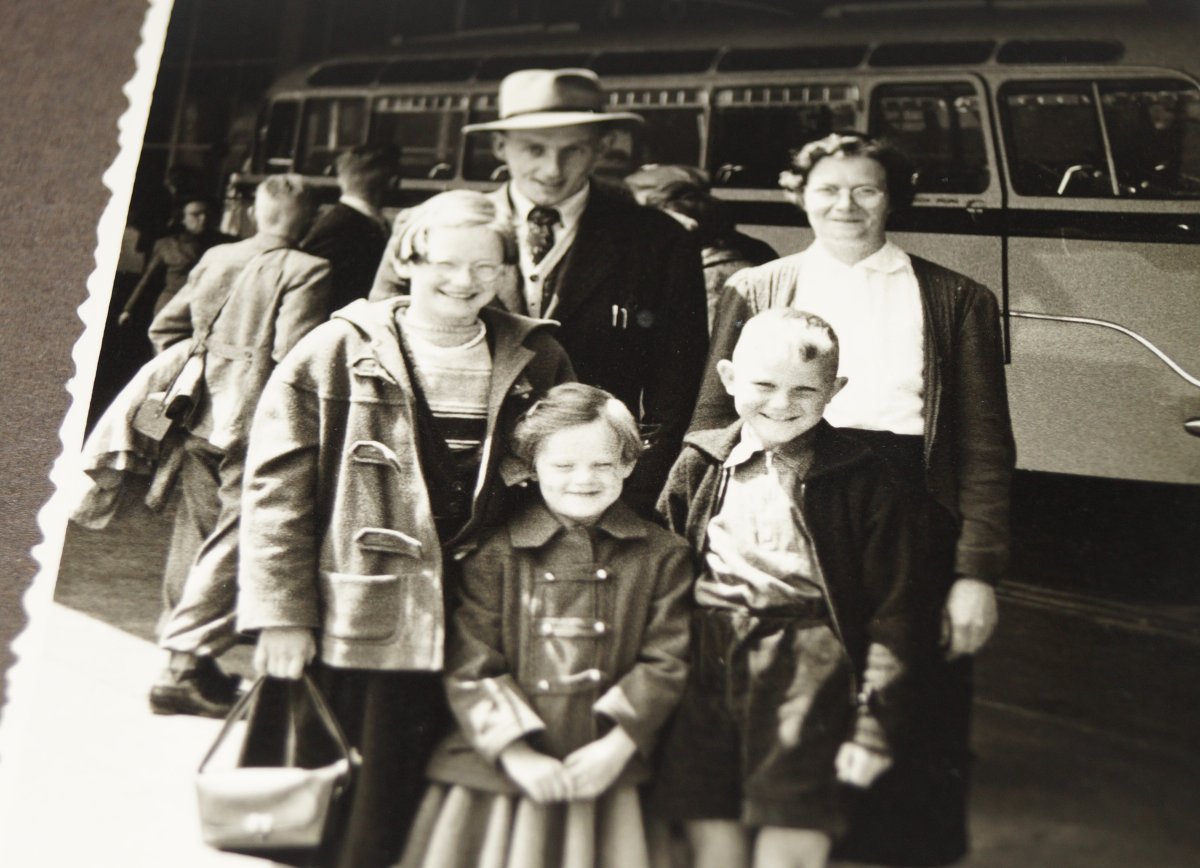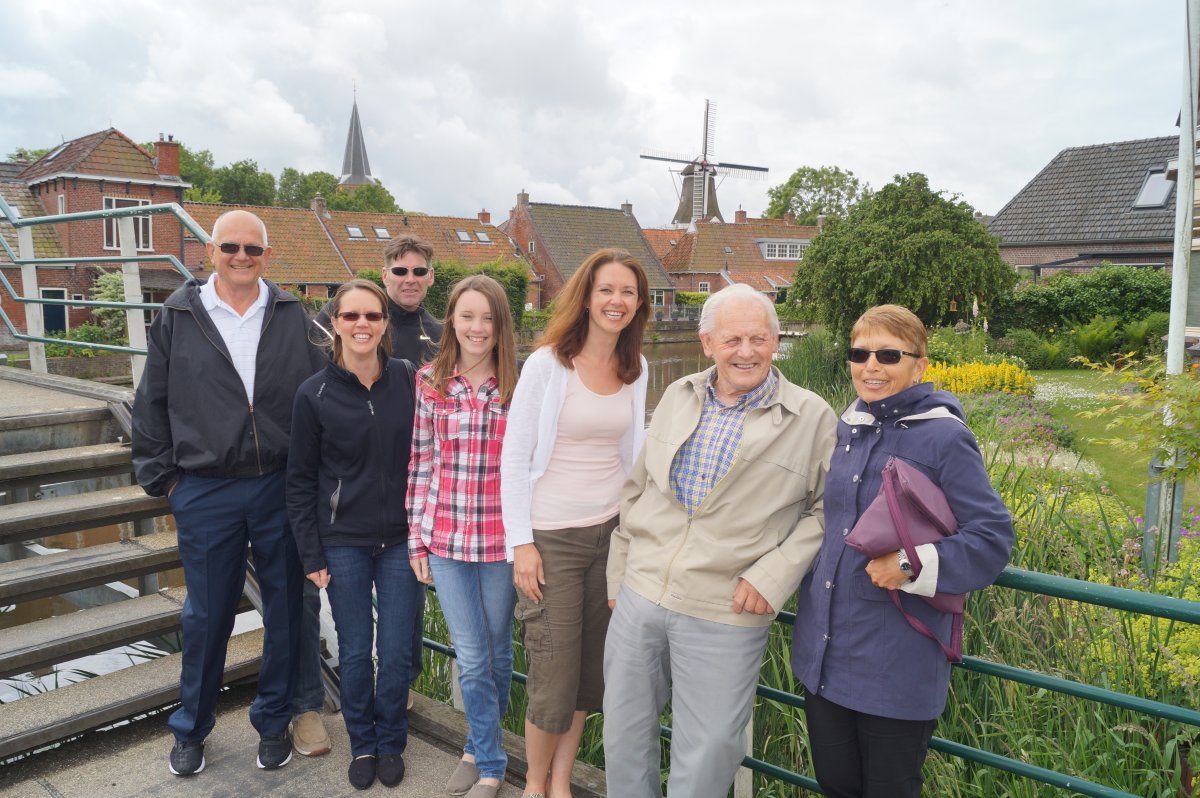EDMONTON — Photographs can hold real power. This year, I took a trip with my family that began with one powerful photo and ended with another that will stay with me forever.

In June 1954, my father, his two sisters and parents boarded a boat in Rotterdam, Netherlands, bound for a better life in Canada. Dad was eight when he left, and for many reasons, he had never gone back to visit.
About two years ago, my sister took to Google to see if she could find any relatives still in Holland, and stumbled across a photograph of Sietse Siegers, my dad’s uncle, whom he had last seen 61 years ago, the day he left for Canada. The photo showed a much older man than the strapping 19 year old my dad remembered, a working man, in overalls and muddy boots, with a small herd of cows.
We had heard stories about how, when my siblings and I were born, our dad’s uncles in Holland had named a cow after each of us. As I examined the photo, I couldn’t help but wonder which one of the cows was Kory.
There were several more pictures of Sietse, with the cows, driving his tractor, sharing tea with friends, loading potatoes. And they weren’t just snapshots. Perfectly composed and lit, they were clearly the work of a professional. We discovered some were on display in a Dutch museum; others had been published by National Geographic. The photographer, Kees van de Veen, is an award-winning and very well-known photographer in the Netherlands.
I emailed to ask how he knew Sietse and if they were still in touch. (Actually, as Kees later recalled, his inbox was suddenly peppered with emails from all of us – me, my sister and my dad.) He told us he had first met Sietse while working for a newspaper in Groningen a few years ago. The paper had heard about a pair of brothers in nearby Winsum, my dad’s hometown, who had worked in the family dairy for years and were about to call it quits.
When Kees and the reporter arrived in the town of about 3,000, they found the brothers driving their tractor through the streets, and spent several hours talking to them, with Kees taking pictures. It turned out just Alke was ready to retire; at 79, Sietse was still going strong.
At the end of the interview, Sietse invited Kees for tea. He declined but promised to call on the old man again.
Some time passed, and Kees ended up back in Winsum for another story. Sietse rolled up in his tractor, pointed his finger and said, “You never called for tea.” They laughed, and Kees joined him for an afternoon cup. They became fast friends – you could even say family. A dedicated bachelor, Sietse attended Kees’s wedding, and now, many years later, his two little ones call Sietse Opa, which is Dutch for grandpa.
Kees said when he read my email to Sietse, he smiled and said how happy he was that his Canadian family still remembers him.
A seed was planted. As we exchanged more emails and family photos, we couldn’t stop talking about joining my dad on a trip back.
He resisted the idea at first. He’ll never admit it, but the flight was likely the stumbling block – he’s never been a fan of flying. Then, on my mom’s 65th birthday, he surprised her with a trip to the Netherlands. He wanted all of us to come along.

Get daily National news
I reached out to Kees and we started planning, our excitement growing. We booked flights and accommodations. By coincidence, we would land in Holland nearly 61 years to the day my dad and his family left for Canada.
I had never heard my Dad speak Dutch – he hadn’t since he was a teenager – and I only ever noticed a faint accent when he was around someone who did. But in the months leading up to our departure, as he practised speaking a little here and there, we were amazed to hear words and phrases emerge from his memory.
We landed in Amsterdam on June 14 and got our bearings there before moving north to Groningen. We had planned for Kees and his wife Marianne to meet us at Sietse’s to help translate.
The beauty of the Dutch countryside is striking. Cows laze in endless green pastures and sheep dot the landscape. In tiny, immaculate towns, homes seem to almost grow from the roads, which are made of similar brick.
Kees, Marianne and their daughters Coosj and Puck greeted us, along with a jumping black lab, probably the happiest dog I’ve ever seen. We soon found out the pup was from next door, but loved to hang out, as there was never a shortage of treats for him.
Sietse came out the barn door, the sparkle in his eyes so familiar, so like my dad’s. A lifelong farmer, he is the only one in town still allowed to keep cows in his backyard, but only a half-dozen now, just to “fatten them up,” as he would say. (A man from Winsum recently posted a video of Sietse’s daily routine, driving through town in his tractor to gather up kitchen scraps, damaged produce and stale bread for his cows.)
Sietse’s 1930s-era home was just as my dad remembered it, save for the indoor toilet and shower, and the breezeway between the house and barn that had been converted to a small kitchen. The formal living room was immaculate, apparently frozen in a time decades past. In the dining room, my father recognized his grandfather’s 100-year-old chair tucked in a corner.
Excitedly, Sietse told him to sit in it, then reached into an old sideboard and began pulling out photo albums. The black-and-white photos had been kept with care, but it was clear from the soft corners, stained with age, he looked at them often.
Sietse stood over my father, explaining each photograph in Dutch. Dad understood some words; the rest of us looked to Kees to explain.
Most pictures we had never seen before. In the 1960s, an out-of-control tanker truck careened into my grandparents’ home on main street Peace River. They made it out the back as the fireball engulfed the front, destroying their photos and everything else they had carefully packed for the voyage across the Atlantic.
One photograph from Sietse’s album that jumped out at me was a snapshot of my dad standing proudly in his short pants, my aunts in their button-up coats, my stoic grandmother, and my grandfather in a suit and tie. What looks like a family off to church in their Sunday best is actually the last photo taken of them before they caught the bus that would take them to Rotterdam to board the SS Zuiderkruis, an immigrant ship to Canada. You can see the excitement in their eyes.
Sietse told us stories from the war: how his older brothers – including my grandfather – were captured by the Germans; the Jewish girl they hid in the house by simply shaving her head; the other Jews who hid in the haystack at the back of the farm. We laughed at the story of one brother saved from the camp by another who plucked him out on a bicycle.
My grandfather was held for more than two years at a work camp in Lubeck, Germany. Ten months after the liberation of Holland and his release from the camp, my father was born.
After coffee and a box of elaborate cakes and pastries that left us in awe, we ventured out into Winsum. My dad needed no directions; he knew exactly how to get to his elementary school, the pub he used to pass every day, and the bridge nicknamed after the Dutch, gin-like spirit Genever.
When we came to the house where he was born, he knew it immediately, could see which trees were new, which had grown. Memories flooded his mind, of how he used to sit and fish from the bridge over the canal that runs alongside the house. Iconic windmills still frame the spot: the perfect picture.
Sietse took us to the family gravesites next. He cares for the plots, spending hours scrubbing the stones with an 89-cent bottle of vinegar a few times a year. He had spruced up the gleaming headstones just for us, pride beaming from his face as we walked through the small cemetery and learned more about our family history.
We laughed and joked as we returned to the house for lunch, the language barrier suddenly not so hard to overcome.
Sietse had spent days preparing for our visit. A stubborn Dutchman, one to never ask for help, he had nevertheless called on his adopted family, Kees and Marianne, to help him clean the house and prepare our meal. Much as it pained him, he had asked a neighbour to feed the cows, and during our visit, several more dropped by to hand over bags of leftover produce and bread for the animals.
Our Dutch farmers lunch was so immense, we wondered how he had managed it in a kitchen about a third the size of a Canadian one. He offered us a beer – orange-flavoured Heineken, the kind only a man who doesn’t drink beer would serve, as Kees joked. More laughter followed.
We toured more of the countryside that afternoon, then said our goodbyes, shedding a few tears. Sietse told us he doesn’t like hugs, but he would allow it this one time.
Hungry as we are to know more about our Dutch roots, this trip was important to my sister and me. For my 14-year-old niece, it meant quality time with her grandparents that she’ll treasure in the years to come.
And what lingers with me? That photo of my eight-year-old dad in June 1954, the same anticipation shining in his eyes as when he stood, once again, in front of his family home, 61 years later.
Kory Siegers is the Senior Assignment Editor at Global Edmonton.

























Comments